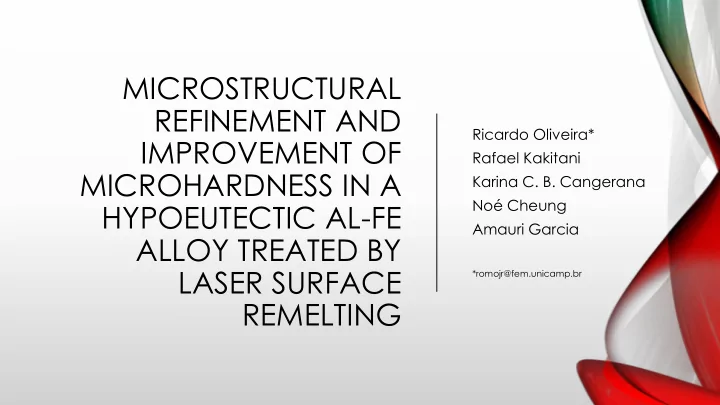

MICROSTRUCTURAL REFINEMENT AND Ricardo Oliveira* IMPROVEMENT OF Rafael Kakitani MICROHARDNESS IN A Karina C. B. Cangerana Noé Cheung HYPOEUTECTIC AL-FE Amauri Garcia ALLOY TREATED BY LASER SURFACE *romojr@fem.unicamp.br REMELTING
INTRODUCTION • There is an increasing interest in Al-Fe alloys for applications demanding high electrical conductivity [1] and/or good thermal stability [2]. • However, the presence of coarse Al 3 Fe plate-like IMC does not provide the required conductivity and mechanical response. One of the four main requirements for designing Al-Fe wire, with a good balance considering strength and electrical conductivity, is IMCs finely dispersed in the Al-matrix [1]. • A possibility to obtain a highly refined microstructure in as-cast alloys is through the laser surface remelting ( LSR ) treatment, where the treated region is remelted and reaches cooling rates at the range of 10 3 -10 8 K/s [3]. Due to these extremely high cooling rates, the microstructure can be 100 times more refined than that untreated [4]. Besides, as the laser equipment could be automatized, components with complex geometries are able to be treated.
OBJECTIVES • This work aims to investigate the influence of process parameters of LSR treatment (average beam power P , scanning speed v and working distance z ) on the remelted tracks at the surface of as-cast Al-1wt.%Fe alloy. • In order to evaluate their influence on the remelted pool: • Depth and width ; • Microstructure ; • Microhardness .
METHODS • A previously solidified Al-1wt.%Fe was submitted to different combinations of LSR parameters shown on Fig. 1 Figure 1. Experiment sample tree parameters for all produced laser remelted pools.
RESULTS • For z 1 = 6 mm , pools dimensions and overall quality were assed trough the optical images presented on Fig. 2 Figure 2. Optical microscope images of laser remelted pools #1 to #9.
RESULTS • For z 1 = 8 mm , pools dimensions and overall quality were assed trough the optical images presented on Fig. 3 Figure 3. Optical microscope images of laser remelted pools #10 to #18.
RESULTS • Table 1 sumarizes quality and dimensional assessment of the remelted pools. Table 1. Quality and dimensions of laser remelting treated pools
RESULTS • Due to the high cooling rates ( Ṫ ) promoted by LSR treatment, the resulting microstructure had an avarege refinement in the order of 14 times , when compared to the untreated substrate. • Microstructural spacing ( λ ) had a low variance between pools, in other words, the different parameter combination resulted in similar microstructures. Suggesting that values approximate to λ ext (extremum spacing) have been reached [5]. Figure 4. Microstructural interphase spacing as function of cooling rate ( Ṫ )
RESULTS • Near the substrate, a cellular structure develops because of the lower growth rates in this region. Hovewer its length is about 10-20 µm, afterwards, as growth rate increases, a finer dendritic structure appears. This transition is depicted on Fig 5. Transition between layers are also highlighted, those are characteristical of epitaxial growth . Figure 5. Microstructure of the remelted track cross section sample #14. Near substrate, middle and near surface zones are highlighted.
RESULTS • An increase in microhardness was already expected, what is worth of noticed is that it even exceeds the extrapoletated function of the solidified alloy shown on Fig 6 Figure 6. Microhardness as function of interphase spacing for Al-1wt% Fe LSR treated alloy. Comparing to the directionally solidified alloy.
In the present study, a laser surface remelting treatment was performed on a Al-1wt.%Fe sample, and the following conclusions were drawn: 1. An operational parameters map, including laser beam scanning speed, average power and working distance was proposed to asses which treatments produce defects and which produces pools with higher widths and depths. CONCLUSIONS 2. LSR operational parameters directly affect the dimensions of treated pools , however direct correlation with microstructural spacing could not be noticed. 3. When comparing with the untreated substrate, microstructural spacing from remelted tracks has refined in an order of 14 times and the microhardness has improved .
FUNDING: This research was funded by CNPq (National Council for Scientific and Technological Development) and CAPES (Coordenação de Aperfeiçoamento de Pessoal de Nível Superior). Acknowlegments ACKNOWLEDGMENTS: The authors would like to thank LNLS – CNPEM for the use of its dependences.
REFERENCES [1] Hou, J.P.; Li, R.; Wang, Q.; Yu, H.Y.; Zhang, Z.J.; Chen, Q.Y.; Ma, H.; Li, X.W.; Zhang, Z.F. Origin of abnormal strength-electrical conductivity relation for an Al-Fe alloy wire. Materialia 2019, 7, 100403. [2] Ye, J.; Guan, R.; Zhao, H.; Yin, A. Effect of Zr content on the precipitation and dynamic softening behavior in Al-Fe-Zr alloys. Mater. Charact. 2020, 162, 110181. [3] Kwok, C.T.; Man, H.C.; Cheng, F.T.; Lo, L.H. Developments in laser-based surface engineering processes: with particular reference to protection against cavitation erosion. Surf. Coat. Technol. 2016, 291, 189-204. [4] Lei, Q.; Ramakrishnan, B.P.; Wang, S.; Wang, Y.; Mazumder, J.; Misra, A. Structural refinement and nanomechanical response of laser remelted Al- Al2Cu lamellar eutectic. Mater. Sci. Eng. A 2017, 706, 115-125. [5] Lien, H.-H.; Mazumder, J.; Wang, J.; Misra, A. Microstructure evolution and high density of nanotwinned ultrafne Si in hypereutectic Al-Si alloy by laser surface remelting. Mater. Charact. 2020, 161, 110147. [6] Silva, B.L.; Garcia, A.; Spinelli, J.E. The effects of microstructure and intermetallic phases of directionally solidified Al-Fe alloys on microhardness. Mater. Lett. 2012, 89, 291-295.
Recommend
More recommend